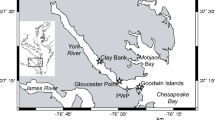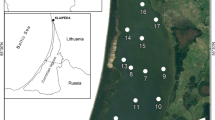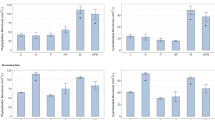Abstract
Two laboratory microcosm experiments were conducted to mimic an annual spring diatom bloom in South San Francisco Bay by isolating the phytoplankton community from the benthic grazing pressure to induce a phytoplankton bloom. The purpose of these experiments was to isolate the impact of a spring diatom bloom on the nutrient and trace metal geochemical cycling. Microcosms were created in 2.5 L incubation bottles and subjected to one of 4 treatments (control, copper [Cu] addition, manganese [Mn] addition, and both Cu and Mn addition) to investigate the toxicity of Cu on the resident plankton and the potential antagonistic effects of Mn on reducing Cu toxicity. Dissolved macronutrient (nitrate + nitrite, phosphate, and silicate), and dissolved and particulate trace metal (Cu, Ni, Mn) concentrations were monitored in the grow-out incubations on a daily basis. Chlorophylla concentrations were also monitored over the course of the experiment and used to calculate diatom-specific growth rates. In the experiments containing ambient South San Francisco Bay surface waters, average specific growth rates were on the order of 1.1 d−1. The induced diatom blooms resulted in significant removal of macronutrients from the microcosms over the course of the experiments. Our research supports previous suggestions that dissolved Ni and Cu concentrations in South San Francisco Bay have a very low biological availability as a result of organic chelation. Ni(EDTA)2− has been found to be the dominant dissolved Ni species by other researchers and Cu speciation analyses from this study and others indicate that > 99% of the dissolved Cu in South San Francisco Bay is strongly chelated as CuL1. The free cupric ion concentration was on the order of 10−12 M. Marked removal of dissolved Mn was observed in the control treatments, well exceeding expected dissolved Mn removal by diatom uptake. Additions of 375 nM Cu resulted in the complete titration of the chelating ligand (L1) concentrations. The elevated [Cu2+] (≈10−8MM) appeared to have a toxic effect on the diatom community observed in the significant decreases in their specific growth rates (μ=0.4 d−1). The suppression of dissolved Mn removal from solution was also observed in treatments spiked with high levels of dissolved Cu, providing support that Mn precipitation was due to biologically mediated oxidation not phytoplankton assimilation. The observed geochemical behavior in the concurrent Cu and Mn addition treatments provide evidence in support of Mn alleviation of Cu toxicity. The biological role in the ambient short-term biogeochemical cycling of Cu and Ni in South San Francisco Bay appears to be minimal due to the inert character of the organic ligand-metal complexes. A significant portion of the annual macronutrient and Mn cycling occurs as a result of spring diatom blooms in South San Francisco Bay.
Similar content being viewed by others
Literature Cited
Beck, N. G. andK. W. Bruland. 2000. Diel biogeochemical cycling in a hyperventilating shallow estuarine environment.Estuaries 23:177–187.
Beck, N. G., R. P. Franks, andK. W. Bruland. 2002. The determination of Cd, Cu, Ni, Zn, and Mn in estuarine water by flow injection ICP-MS.Analytica Chimica Acta 455:11–22.
Bedsworth, W. W. andD. L. Sedlak. 1999. Sources and environmental fate of strongly complexed nickel in estuarine waters: The role of ethylenediaminetetraacetate.Environmental Science and Technology 33:926–931.
Boothman, W. S. 1988. Characterization of trace metal association with polluted marine sediments by selective extractions, p. 81–92.In J. J. Lichtenberg, W. Winter, C. S. Weber, and A. Fradkin (eds.), Chemical and Biological Characterization of Municipal Sludges, Sediments, Dredge Spoils, and Drilling Muds. ASTM, Baltimore, Maryland.
Brand, L. E., W. G. Sunda, andR. R. L. Guillard. 1986. Reduction of marine phytoplankton reproduction rates by copper and cadmium.Journal of Experimental Marine Biology and Ecology 96:225–250.
Bruland, K. W., E. L. Rue, J. R. Donat, S. Skrabal, andJ. Moffett. 2000. An intercomparison of voltametric approaches to determine the chemical speciation of dissolved copper in a coastal seawater sample.Analytica Chimica Acta 405:99–113.
Bruland, K. W., E. L. Rue, andG. J. Smith. 2001. The influence of iron and macronutrients in coastal upwelling regimes off central California: Implications for extensive blooms of large diatoms.Limnology and Oceanography 46:1661–1674.
Brzezinski, M. A. 1985. The Si∶C∶N ratio of marine diatoms: Interspecific variability and the effect of some environmental variables.Journal of Phycology 21:347–357.
Cleorn, J. E. 1996. Phytoplankton bloom dynamics in coastal ecosystems: A review with some general lessons from sustained investigation of San francisco Bay, California.Journal of Geophysical Reviews 34:127–168.
Cloern, J. 2001. Our evolving conceptual model of the coastal eutrophication problem.Marine Ecological Progress Series 210:223–253.
Cloern, J., B. Cole, J. Edmunds, T. Schraga, andA. Armsberg. 1999. Patterns of water-quality variability in San Francisco Bay during the first six years of the RMP, 1993–1998. The San Francisco Estuary Institute, Richmond, California.
Conomos, T. J. 1979. Properties and circulation of San Francisco Bay waters, p. 47–86.In T. J. Conomos (ed.), San Francisco, Bay: The Urbanized Estuary. Pac. Div. AAAS, San Francisco, California.
Donat, J. R., K. A. Lao, andK. W. Bruland. 1994. Speciation of dissolved copper and nickel in south San Francisco Bay: A multi-method approach.Analytica Chimica Acta 284:547–571.
Flegal, A. R., I. Rivera-Duarte, P. Ritson, G. M. Scelfo, G. J. Smith, M. R. Gordon, andS. Sanudo-Wilhelmy. 1996. Metal contamination in San Francisco Bay waters: Historic perturbations, contemporary concentrations, and future considerations, p. 173–188.In J. T. Hollibaugh (ed.). San Francisco Bay: The Ecosystem. Pacific Division of the American Association for the Advancement of Science. San Francisco, California.
Gee, A. K. andK. W. Bruland. 2002. Tracing Ni, Cu, and Zn kinetics and equilibrium partitioning between the dissolved and particulate phases in south San Francisco Bay, California, using stable isotopes and HR-ICPMS.Geochemica Cosmochimica Acta 66:3062–3082.
Kozelka, P. B. andK. W. Bruland. 1998. Chemical speciation of dissolved Cu, Zn, Cd, Pb in Narragansett Bay, Rhode Island.Marine Chemistry 60:267–282.
Kudela, R. M. andR. C. Dugdale. 2000. Nutrient regulation of phytoplankton productivity in Monterey Bay, California.Deep Sea Research II 47:1023–1053.
Kuwabara, J. S., C. C. Y. Chang, J. E. Cloern, T. L. Fries, J. A. Davis, andS. N. Luoma. 1989. Trace metal association in the water column of south San Francisco Bay, California.Estuarine, Coastal and Shelf Science 28:307–325.
Luoma, S. N., A. van Geen, B. G. Lee, andJ. E. Cloern. 1998. Metal uptake by phytoplankton during a bloom in south San Francisco Bay: Implications for metal cycling in estuaries.Limnology and Oceanography 43:1007–1016.
Moffett, J. W. andL. E. Brand. 1996. Production of strong, extra-cellular Cu chelators by marine cyanobacteria in response to Cu stress.Limnology and Oceanography 41:388–395.
Nichols, F. H., J. E. Cloern, S. N. Luoma, andD. H. Peterson. 1986. The modification of an estuary.Science 231:567–573.
Palenik, B. andA. R. Flegal. 1999. Cyanobacterial populations in the San Francisco Bay, Regional Monitoring Program for Trace Substances. San Francisco Estuary Institute, Richmond, California.
Parsons, T. R., Y. Maita, andC. M. Lalli. 1984. Flourometric determination of chlorophylls, p. 107–109.In A Manual of Chemical and Biological Methods of Seawater Analysis. Pergamon Press, New York.
Roitz, J. andK. W. Bruland. 1997. Determination of dissolved manganese (II) in estuarine and coastal waters by differential pulse cathodic stripping voltametry.Analytica Chemica Acta 344:175–180.
Ruzic, I. 1982. Theoretical aspects of the direct titration of natural waters and its information yield for trace metal speciation.Analytica Chimica Acta 140:99–113.
Stumm, W. andJ. J. Morgan. 1996. Aquatic Chemistry; Chemical equilibria and rates in natural waters, 3rd edition. Wiley & Sons, Inc., New York.
Sunda, W. G., G. T. Barber, andS. A. Huntsman. 1981. Phytoplankton growth in nutrient rich seawater: Importance of copper-manganese cellular interactions.Journal of Marine Research 39:567–586.
Sunda, W. G. andS. A. Huntsman. 1987. Microbial oxidation of manganese in a North Carolina estuary.Limnology and Oceanography 32:552–564.
Sunda, W. G. andS. A. Huntsman. 1995. Regulation of copper concentrations in the oceanic nutricline by phytoplankton uptake and regeneration cycles.Limnology and Oceanography 40:132–137.
Sunda, W. G. andS. A. Huntsman. 1998a. Processes regulating cellular metal accumulation and physiological effects: Phytoplankton as model systems.The Science of the Total Environment 219:165–181.
Sunda, W. G. andS. A. Huntsman. 1998b. Interactive effects of external manganese, the toxic metals copper and zinc, and light in controlling cellular manganese and growth in a coastal diatom.Limnology and Oceanography 43:1467–1475.
Tebo, B. M. 1991. Manganese (II) oxidation in the suboxic zone of the Black Sea.Deep-Sea Research 38:S883-S905.
van den Berg, C. M. G. 1982. Determination of copper complexation with natural organic ligands in seawater by equilibrium with MnO2.Marine Chemistry 11:307–322.
Author information
Authors and Affiliations
Corresponding author
Rights and permissions
About this article
Cite this article
Beck, N.G., Bruland, K.W. & Rue, E.L. Short-term biogeochemical influence of a diatom bloom on the nutrient and trace metal concentrations in South San Francisco Bay microcosm experiments. Estuaries 25, 1063–1076 (2002). https://doi.org/10.1007/BF02692204
Received:
Accepted:
Issue Date:
DOI: https://doi.org/10.1007/BF02692204




